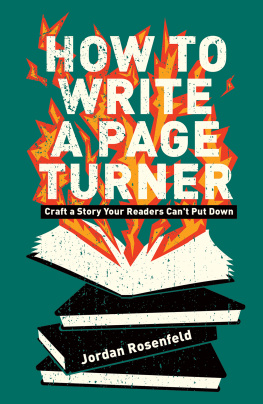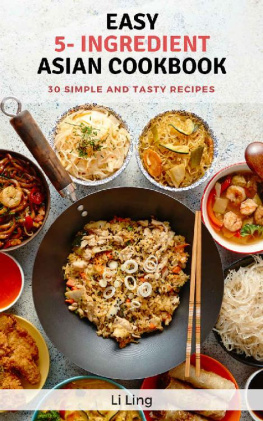Table of Contents
FOR MOM, FOR ALL THE TASTING, TESTING, AND LOVE.
ACKNOWLEDGMENTS
Ive learned to be rather picky about whom I let help me with this sort of thing: better to drag a few unlucky souls through the muck of recipe testing and paper-crumpling edits than bother everybody I know. To those select few, then, who were kind or nave enough to take part in this searing saga, I am truly indebted.
The recipe-testing bait was taken by a powerful triumvirate of culinarily talented friends and family. My brother Peter applied his meticulous approach to classical music to the testing of sauces. My cook-book author mother Julie Riven Jaye helped with marathon sessions in my tiny kitchen; carefully applied guilt trips might have got her there, but her energy, palate, and organization were instrumental. And the cheerful willingness of Andrew Money-man Pease could always be counted on to inspire every step of this process.
Sharon Bowers, my agent, is responsible for nurturing this project from its inception. It is valuable, almost indispensable, to have someone like Sharon always at the ready with encouragement. Susie Middleton, in addition to being a great friend, gave thoughtful counsel on many of the sauces in this book. And Giuliano Bugialli, for years a wonderful mentor, received Italian cooking questions with his trademark mix of wit and impatience. Im also grateful to the many members of the Fine Cooking family who have continued to push me along through the years, including Rebecca Freedman, Jennifer Armentrout, Abby Dodge, Molly Stevens, Pam Anderson, and Sarah Jay. And thank you to the b.good team who allowed me the freedom to both write and cook.
The structure of this book was due in large part to its editor Geoff Stone, who helped mold the original concept into a sophisticated formula. Also from Running Press, Cisca Schreefel guided the manuscript through its many stages of editing, Martha Whitt helped tidy it up, and the publicity department led by Seta Zink got it out there.
And, finally, Marguerite played the role of on-call guidance counselor and resident dishwasher with love and without complaint. Thank you.
INTRODUCTION
Its best you sit down first. I dont take you for the fainting kind (introduction readers generally arent), but this book contains potentially explosive elements that are intended to alter the very way you live. OK, fine ... alter the way you cook, which, of course, could change the way you live ... stay with me here.
No worries, Ive no interest in your daily donut dalliances or late-afternoon chocolate dealings. Its dinner that I care about and dinner where I can help. Im particularly focused on that brief, dangerous period when you get home each night, hungry and tired and uncertain of what to make or, more simply, what to eat. Studies show... ok, my studies show... that hungry, tired people tend to make bad food decisions. That is unless these same hungry, tired people are somehow presented with a better option, an easier way. This book is that better option and its ramifications are why youre now seated.
By the end of your journey through Sear, Sauce, and Serve, you will be able to feed yourself and your loved ones better and more quickly than ever before. And youll do this through the help of a very basic formula, a simple two-step cooking process that pairs four high-heat cooking methods with a vast array of jazzy, but immensely easy sauces. Continue reading and you will learn how to make dinner in a setting that is far more real and pressure-packed than any Iron Chef Kitchen Stadium. Its called Monday night. And that secret ingredient? It may feel like just that ... a @#$%!! secret. But youll take a deep breath and channel this formula and soon enough youll pick up all sorts of secret ingredients and little tricks to prepare them.
I dont know whether this book will help you sleep more soundly or influence others more profoundly, but it will help you cook better and, damn it, good-cooking, well-fed people do well in life.
Before I explain how this whole formula works and how it will change all things cooking for you, I might as well tell you how I came to it myself. The story begins back when I was a little guy. As most moms do, mine always insisted that I make my bed and fold my clothes before leaving the house. Unlike most kids, though, I took to the whole thing in a mildly OCD way. This neatness bug stuck with me, and by the time I was cooking in restaurant kitchens in my teens, I was mentally organizing and reorganizing every technique I came across. And this wasnt all bad; it helped me quickly discover that cooking well wasnt so much about memorizing recipes as it was about understanding, absorbing, and mastering the basics. Build this foundation, I thought to myself (yes, like in one of those sitcom voice-overs when a character writes a letter), and one day youll be able to get all cool and creative.
Sopping Up Every Last Drop
Dan Freedbergs house was halfway between mine and my elementary school. So every morning my little brother and I would shoot down Nobscot Road, through the Connors driveway, over a little fence, down Dans backyard, up the back steps, and into the kitchen where we would ask Dan, breathlessly, if he wanted to join us on the walk to school.
The scene in the kitchen was almost always the same. Dan would have a plate of over-easy eggs before him and one of his parents would be nearby, part pleading, part imploring him to eat. Dan would usually eat some of the eggs, but he always left large swaths of the runny yolks behind.
Those abandoned egg yolks killed me. I loved eggs and I was always hungry and there sat those yolks, untouched and unready for the dishwasher. Cereals (and were not talking sugar cereals either, but healthy Os and flakes) were the only things doing in my house for weekday breakfasts. Eggs were weekend food, special food. And not only did Dan get eggs every morning, but they were so plain to him that he left the best part behind. I eyed those yolks longingly, thinking if only they had been mine.
Im not going to get all dramatic and claim that those untouched yolks were the genesis for my writing a book on saucessome sort of emotional hole that needed to be filled through high-heat cooking. But I do believe that at a young age, we become the kind of people who either finish our plates (or are forced to do so) or not. And not only was I a finish-my-plate type, but even as a kid I was a sauce-picker-upper; the type to grab a hunk of bread and sop up whatever liquid (or yolk) remained. I think people who love to eat start that way and just keep on eating. The savory pull that draws us to sauces in the first place keeps us there til theyre all gone.
I never went to cooking school so I had to build this foundation on my own. And because Id somehow managed to work my way into Bostons fanciest kitchens by my early twenties, I had to teach myself quickly so I wouldnt be exposed by all the slick CIA (the Culinary Institute of America, not the agency) grads darting past me. So I began a manic game of catch-up, spending many late nights in my dingy bachelors apartment turning vegetables or practicing hollandaise sauce or butchering skate wing: in essence, sorting out (and re-sorting) most everything there was to learn about cooking.
I wasnt dating much back then. To be honest, I wasnt dating at all. Worse, I always smelled like food, and not chocolate cake or blueberry pie, mind you, but onions and garlic and shallots (yeah, oh my). After a couple of years of this self-inflicted kitchen crash course, I finally caught up. And, along the way, I fine-tuned my slightly obsessive approach to cooking. I would take the core techniques and deconstruct them to their base parts (The first step to saut scallops is to pat them completely dry to avoid sticking and encourage caramelization. Next, heat up the pan until its ripping hot...) and then build them back up in my mind, kind of like those car enthusiasts who take apart an engine only to reassemble it. From this approach, I learned not only how to saut scallops but also what this technique had in common with grilling shrimp or broiling chicken breasts. Clearly, I wasnt building a fuel cell or mapping DNA strains, but the experience was revelatory, and because I mostly taught myself I got good at teaching others.
















